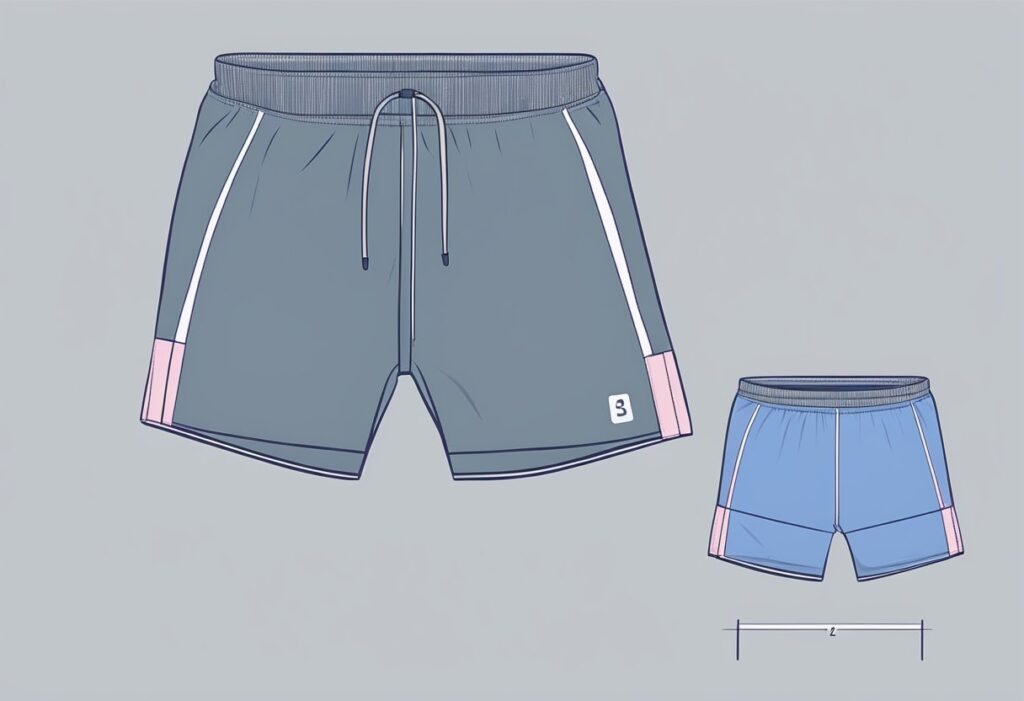What is the Ideal Length for Running Shorts
The length of running shorts varies greatly among runners, with some preferring longer shorts for more coverage and others opting for shorter shorts to increase mobility. However, there is a growing debate among runners about what the ideal length for running shorts should be. While personal preference and comfort are important factors, there are also practical considerations to take into account.
One factor to consider when choosing the length of running shorts is the weather. In hotter temperatures, shorter shorts may be more comfortable and allow for more ventilation, while longer shorts may be preferred in cooler temperatures for added warmth. Another factor to consider is the type of running being done. Sprinters may prefer shorter shorts for increased range of motion, while longer shorts may be more practical for long-distance runners who want more coverage and protection against chafing. Ultimately, the ideal length for running shorts may depend on the individual’s body type, running style, and personal preferences.
Determining the Ideal Length
When it comes to running shorts, the ideal length varies based on the type of running one is doing. In this section, we will explore the ideal length for sprinters, middle-distance runners, and long-distance runners.
Short Length for Sprinters
Sprinters require a shorter length for their running shorts as it allows for maximum range of motion and flexibility. The ideal length for sprinters is between 1 to 3 inches above the knee. This length allows for the least amount of fabric to interfere with their leg movements, making it easier for them to run at their maximum speed.
Medium Length for Middle-Distance Runners
Middle-distance runners require a slightly longer length for their running shorts as they need more coverage to prevent chafing. The ideal length for middle-distance runners is between 3 to 5 inches above the knee. This length provides enough coverage to prevent chafing while still allowing for a good range of motion.
Long Length for Long-Distance Runners
Long-distance runners require the longest length for their running shorts as they need more coverage to prevent chafing and irritation caused by prolonged friction. The ideal length for long-distance runners is between 5 to 7 inches above the knee. This length provides enough coverage to prevent chafing and irritation while still allowing for a good range of motion.
In conclusion, determining the ideal length for running shorts depends on the type of running one is doing. Sprinters require a shorter length, while middle-distance runners require a medium length, and long-distance runners require the longest length. It is important to choose the right length to ensure maximum comfort and performance during a run.
Factors Influencing Short Length
When it comes to choosing the ideal length for running shorts, there are several factors that come into play. Some of the most significant factors influencing short length are discussed below.
Material and Flexibility
The type of material used in the shorts is a crucial factor to consider when determining the ideal length. Running shorts are typically made from lightweight and breathable materials that allow for maximum airflow and ventilation. The fabric should also be flexible to ensure that the shorts move with the runner’s body and do not restrict movement.
Weather and Climate Adaptability
The weather and climate in which the runner will be running is another important consideration. In hot and humid conditions, shorter shorts may be preferred to allow for better ventilation and cooling. In cooler temperatures, longer shorts may be more appropriate to keep the runner warm.
Personal Comfort and Preference
Ultimately, personal comfort and preference play a significant role in determining the ideal length for running shorts. Some runners may prefer shorter shorts for a greater range of motion, while others may prefer longer shorts for added coverage. It is essential to choose a length that feels comfortable and allows for optimal performance.
In conclusion, the ideal length for running shorts depends on several factors. It is important to consider the material and flexibility of the shorts, as well as the weather and climate in which the runner will be running. Ultimately, personal comfort and preference should be the deciding factor in choosing the ideal length.
Impact on Performance
When it comes to running shorts, the length can have a significant impact on performance. The ideal length will depend on various factors, including the runner’s body type, the type of running activity, and personal preferences.
Aerodynamics and Speed
Aerodynamics is a crucial factor in running, especially for long-distance runners. The length of the shorts can affect the runner’s aerodynamics and speed. Shorter shorts tend to be more aerodynamic, reducing drag and allowing for faster speeds. However, if the shorts are too short, they can cause discomfort and chafing.
On the other hand, longer shorts tend to be less aerodynamic, but they provide more coverage and can help prevent chafing. It’s essential to find a length that balances aerodynamics with comfort.
Mobility and Range of Motion
Mobility and range of motion are crucial for runners, especially for those engaging in activities that require a lot of movement, such as sprinting. The length of the shorts can affect the runner’s mobility and range of motion.
Shorter shorts tend to provide more mobility and range of motion, allowing for more natural movement of the legs. However, they may not provide enough coverage and can be uncomfortable for some runners.
Longer shorts tend to provide more coverage, but they can limit mobility and range of motion. It’s essential to find a length that balances coverage with mobility and range of motion.
In conclusion, the ideal length for running shorts will depend on various factors, including the runner’s body type, the type of running activity, and personal preferences. It’s crucial to find a length that balances aerodynamics, comfort, coverage, mobility, and range of motion.
Running Shorts Features
When it comes to running shorts, there are a few key features that can make all the difference in terms of comfort, performance, and safety. Here are some of the most important features to look for in running shorts:
Built-In Underwear
Many running shorts come with built-in underwear, which can help to provide support and prevent chafing. The ideal length for running shorts with built-in underwear will depend on personal preference, but most runners prefer a length that falls just above the knee.
Pockets and Storage Options
Pockets and storage options are important for runners who need to carry essentials like keys, phones, and energy gels. Look for shorts with secure pockets that won’t bounce around while you run. Some shorts even have multiple pockets for added convenience.
Reflective Elements for Safety
If you plan to run in low-light conditions, reflective elements are a must-have feature in running shorts. Look for shorts with reflective detailing on the front, back, and sides to help you stay visible to drivers and other runners.
Overall, the ideal length for running shorts will depend on personal preference and the type of running you plan to do. However, by looking for shorts with built-in underwear, pockets and storage options, and reflective elements, you can ensure that you have a comfortable, functional, and safe pair of shorts for your next run.
Choosing the Right Running Shorts
When it comes to running shorts, there are several factors to consider before making a purchase. The ideal length for running shorts is a matter of personal preference and can vary depending on the individual’s body type and running style. However, there are a few key considerations to keep in mind when choosing the right running shorts.
Brand and Quality
When it comes to running shorts, it’s important to choose a reputable brand that produces high-quality shorts. Look for brands that specialize in athletic wear and have a proven track record of producing durable and comfortable running shorts. Quality materials and construction can make a big difference in the comfort and performance of your running shorts.
Price Considerations
Running shorts can range in price from budget-friendly options to high-end designer shorts. While it may be tempting to go for the cheapest option, investing in a higher-quality pair of shorts can be worth the extra cost in terms of comfort and longevity. It’s important to find a balance between price and quality that works for your budget.
Finding the Right Fit
One of the most important factors to consider when choosing running shorts is finding the right fit. Running shorts should fit snugly but not be too tight, and should allow for a full range of motion. Look for shorts with adjustable waistbands or drawstrings for a customizable fit. It’s also important to consider the length of the shorts, as longer shorts can provide more coverage and protection while shorter shorts can allow for greater freedom of movement.
Overall, when choosing the right running shorts, it’s important to consider brand and quality, price, and finding the right fit. By taking these factors into account, runners can find the perfect pair of shorts to help them perform at their best.
Also See Below posts:
- Purdue University Scholarship 2024-25 in USA (Funded)
- University of Alberta Scholarships 2024-25 in Canada (Fully Funded)
- Finland Scholarships Without IELTS 2024 | Free Study in Finland
- WHO Free Online Courses 2024-2025 with Free Certificates
- What are the best materials for moisture-wicking running shorts
- How can I choose the right size of running shorts
- What are some creative ways to layer with fashion shorts in cooler weather
- What shoes and accessories complement fashion shorts outfits
- How do I choose the right fabric and texture for fashion shorts
- How can I find the perfect fit when shopping for fashion shorts
- What are some tips for incorporating fashion shorts into my everyday wardrobe
- How do I find running shorts with adequate pockets for carrying essentials
- How can I create a flattering silhouette with fashion shorts?
- How can I style fashion shorts for different occasions
- What are the benefits of UV protection in outdoor shorts
- What is the ideal length for running shorts


